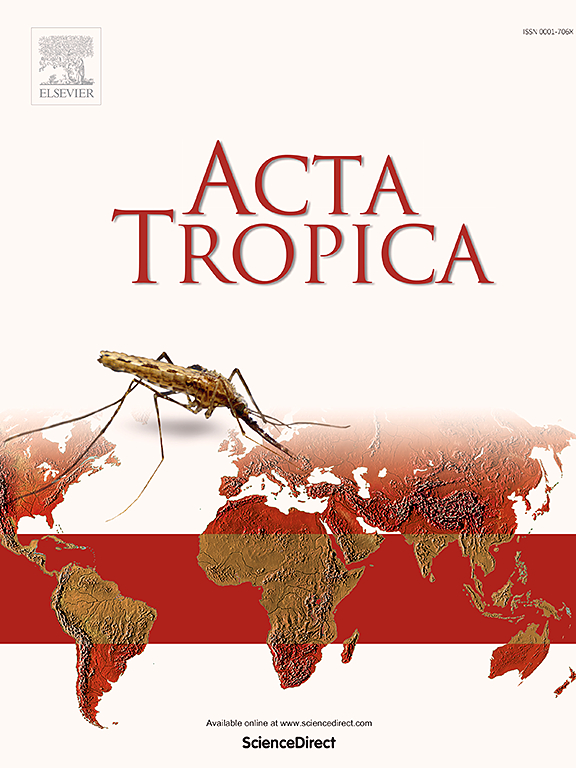Global potential distribution and realized niche conservatism during biological invasion of Culicoides imicola from Africa to the Mediterranean basin of Europe
IF 2.1
3区 医学
Q2 PARASITOLOGY
引用次数: 0
Abstract
Many Culicoides species transmit arboviruses that affect animals and humans. Culicoides imicola, a key vector of bluetongue virus (BTV), has expanded its range from Africa to Europe, spreading disease. Biting midges breed in diverse habitats and contribute significantly to the epidemiology of vector-borne diseases. In the present study, C. imicola occurrences were obtained and spatially filtered, resulting in 703 occurrences divided into the training and validation datasets (a 70–30 % split). Four bioclimatic variable sets were created based on their contributions to environmental niche modeling. Ecological niche models were built using combinations of variables and feature classes, and evaluated based on the Akaike information criterion, the omission rate, and partial receiver operating characteristic curve analysis using the Kuenm package in R version 4.2.3. Niche comparison between the native (Africa) and invaded (Europe) regions was performed using NicheA 3.0 and niche dynamics, including unfilling, expansion, and stability, with ecoregions delineating native and invaded areas determined using the Ecospat package in R version 4.2.3. The results indicated that C. imicola had a wide transcontinental distribution; the model predicted suitable habitats mainly in subtropical and temperate zones. The niche overlap analysis showed that the Jaccard index and Schoener’s D predicted low niche overlap between the native and invaded areas, with limited expansion and 93.6 % niche stability. The niches of C. imicola’s native and invaded areas were more similar than would be expected by chance, but they were not equivalent. In conclusion, there was high niche stability for C. imicola between Africa and Mediterranean Europe, with temperature strongly influencing its distribution.

库蠓从非洲向欧洲地中海盆地生物入侵的全球潜在分布及其生态位保守性
许多库蠓传播影响动物和人类的虫媒病毒。蓝舌病病毒(BTV)的主要媒介库蠓(Culicoides imicola)已将其范围从非洲扩大到欧洲,从而传播疾病。蠓在不同的生境中繁殖,对媒介传播疾病的流行病学有重要贡献。在本研究中,获得了C. imicola的出现次数并进行了空间过滤,得到703次出现次数分为训练和验证数据集(70 - 30%的分割)。根据其对环境生态位模型的贡献,创建了4个生物气候变量集。采用变量和特征类组合的方法建立生态位模型,利用R 4.2.3版本的Kuenm软件包,基于Akaike信息准则、遗漏率和部分接收者工作特征曲线分析对生态位模型进行评价。利用NicheA 3.0和生态位动态(包括未填充、扩展和稳定性)对原生(非洲)和入侵(欧洲)区域进行生态位比较,并使用R 4.2.3版本中的Ecospat软件包确定生态区划分原生区和入侵区。结果表明,紫杉具有广泛的跨洲分布;该模型预测的适宜生境主要分布在亚热带和温带。生态位重叠分析表明,利用Jaccard指数和Schoener’s D预测原生地与入侵地生态位重叠度较低,扩展有限,生态位稳定性为93.6%。西米科拉原生区与入侵区生态位的相似性高于偶然预测,但并非完全相等。综上所述,imicola在非洲和地中海欧洲之间具有较高的生态位稳定性,温度对其分布有很强的影响。
本文章由计算机程序翻译,如有差异,请以英文原文为准。
求助全文
约1分钟内获得全文
求助全文
来源期刊

Acta tropica
医学-寄生虫学
CiteScore
5.40
自引率
11.10%
发文量
383
审稿时长
37 days
期刊介绍:
Acta Tropica, is an international journal on infectious diseases that covers public health sciences and biomedical research with particular emphasis on topics relevant to human and animal health in the tropics and the subtropics.
 求助内容:
求助内容: 应助结果提醒方式:
应助结果提醒方式:


